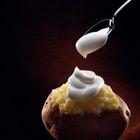
Most Boston cream filling uses eggs and cornstarch or flour as thickeners. Various preparation missteps cause runny pastry cream. Overcooking, undercooking and imprecise measurements -- including too little of a thickening agent or too much sugar or fat -- are common. You may not have brought the cream to a boil quickly enough or heated the eggs enough. If you added lemon juice or another acidic liquid, it interferes with cornstarch's thickening. You may be able to save runny pastry cream; however, certain errors can't be corrected while maintaining the right taste, texture and appearance.
Step 1
Put the boston cream filling into a bowl and cover it with plastic wrap after preparation. Press the wrap down onto the surface of the pastry cream to prevent a film from forming as it sets.
Step 2
Refrigerate the cream for three hours to two days, as it won't completely thicken until it's chilled. Leave the pastry cream alone while it chills. Don't stir, whisk or otherwise play with it to examine its consistency. Doing so breaks down the starch, interfering with thickening.
Step 3
Put water in the bottom of a double boiler and place the inner pot inside if the Boston cream filling remains runny after chilling. A double boiler lets you gently reheat the relatively fragile pastry cream to rework it. If you don't have a double boiler, create the same effect by putting a little water in one saucepan and placing a second one inside it without letting it touch the water. Bring the water to a simmer.
Step 4
Mix a teaspoon or 2 of cornstarch with an equal amount of cold water, milk or cream. Stir until blended into a slurry. This is the best way to add a starch-based thickening agent to a warm or hot preparation without lumps forming. Use flour instead of cornstarch if your cream contains a citrus juice or other acidic component..
Step 5
Spoon the runny pastry cream into the inner pot of the double boiler to gently heat it. Stir occasionally and warm it to 175 degrees Fahrenheit as measured by a cooking thermometer, which is the temperature at which the cream begins to chemically thicken.
Step 6
Pour a small amount of the cornstarch or flour slurry into the pastry cream. Whisk continuously for a minute and watch for thickening. Add another small amount if necessary and continue whisking until you see the first bubble or two in the surface of the filling.
Step 7
Return the Boston cream filling to a bowl and cover it with plastic wrap, pressing the wrap down onto the surface of the cream. Refrigerate the cream again for at least three hours; it keeps for up to two days, but remember to subtract the first period of refrigeration from the total.
Related Articles

How to Make Whipped Frosting Without ...

How to Make Scalded Cream

How to Harden Up Whipped Cream

How to Make Stiff Peaks in Whipped Cream

How to Fix Grainy Whipped Ganache

How to Bring Cream to a Boil

What Is "Cultured Cream"?

How to Make a Bavarian Cream Filling

How to Thicken Cream Filling

How Many Calories Are in Cream of Wheat?

How to Use a Cream With Arginine

Does Cream Curdle When It Goes Bad?

What Does Rennet Do in Ice Cream?

How to Make a Cream Sauce With ...

How to Mix Lemon Curd With Whipping ...

Does Cream Spoil?

How to Substitute Cream for Buttermilk

The Cream for My Tiramisu Is Too Watery
How Can I Prepare Whipping Cream Ahead ...

What Makes Cream Liqueur Curdle in ...
References
Writer Bio
Eric Mohrman is a food and drink, travel, and lifestyle writer living in Orlando, Florida. He has professional experience to complement his love of cooking and eating, having worked for 10 years both front- and back-of-house in casual and fine dining restaurants. He has written print and web pieces on food and drink topics for Visit Florida, Orlando Style Magazine, CrushBrew Magazine, Agent Magazine, Dollar Stretcher Magazine, The 863 Magazine and other publications.
Photo Credits
George Doyle/Stockbyte/Getty Images